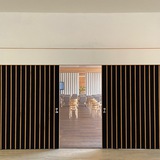«В конце концов, жизнь научила нас контролировать выражение наших лиц, маскируя эмоции, но она не научила нас контролировать себя в момент прыжка. Я просил знаменитостей подпрыгнуть, чтобы увидеть их истинные черты характера, такие как самомнение или неуверенность в себе». Во время прыжка «человек сбрасывает маску и показывает свое настоящее лицо. Нам остается только запечатлеть его».
———
“After all, life has taught us to control and disguise our facial expressions, but it has not taught us to control our jumps. I wanted to see famous people reveal, in a jump, self-importance or their insecurity, and many other traits”. In a jump, “the mask falls. The real self becomes visible. One has only to snap it with the camera.”
———
“After all, life has taught us to control and disguise our facial expressions, but it has not taught us to control our jumps. I wanted to see famous people reveal, in a jump, self-importance or their insecurity, and many other traits”. In a jump, “the mask falls. The real self becomes visible. One has only to snap it with the camera.”
👍3
В объектив Халсмана попали многие известные люди: актеры, художники, музыканты, модели, писатели, архитекторы (найдете архитектора?), журналисты. Фотограф заставил прыгать даже Ричарда Никсона и герцога и герцогиню Виндзорских.
Используя инструментарий прыгологии, Халсман мог составить портрет человека по снимку. Например, с точки зрения прыгологии, интроверты во время прыжка прижимают руки к телу, а люди с амбициями широко разводят их.
———
Halsman photographed all kinds of celebrities: actors, artists, musicians, writers, architects (can you spot one here?), journalists, etc. He even made Richard Nixon and the Duke and the Duchess of Windsor jump in front of his camera.
Using jumpology as a tool, Halsman could piece together a psychological portrait of each of his clients. For example, jumpology tells us that introverts tend to not use their arms when jumping while those with ambitions jump with arms outstretched.
Используя инструментарий прыгологии, Халсман мог составить портрет человека по снимку. Например, с точки зрения прыгологии, интроверты во время прыжка прижимают руки к телу, а люди с амбициями широко разводят их.
———
Halsman photographed all kinds of celebrities: actors, artists, musicians, writers, architects (can you spot one here?), journalists, etc. He even made Richard Nixon and the Duke and the Duchess of Windsor jump in front of his camera.
Using jumpology as a tool, Halsman could piece together a psychological portrait of each of his clients. For example, jumpology tells us that introverts tend to not use their arms when jumping while those with ambitions jump with arms outstretched.
«Все способное прыгать население Земли делится на тех, кто старается прыгнуть как можно выше, и тех, кому все равно». (Ф. Халсман)
———
"Jumping humanity can be divided into two categories: one which tries to jump as high as possible and one which doesn’t care.” (P. Halsman)
(photos here and above: Philippe Halsman, Magnum Photos, cameralabs.org, theatlantic.com)
———
"Jumping humanity can be divided into two categories: one which tries to jump as high as possible and one which doesn’t care.” (P. Halsman)
(photos here and above: Philippe Halsman, Magnum Photos, cameralabs.org, theatlantic.com)
❤1
Упомянутый на прошлой неделе Жан-Мишель Франк запомнился, конечно, многими блистательными работами, но отдельного упоминания заслуживают его светильники. Минималистичные, как и интерьеры, оформленные по его проектам (закончив очередной проект, Франк говорил заказчику: «Вуаля, я свою работу выполнил, можете приступать к разрушению»), они гораздо поэтичнее, чем функционалистские работы многих его современников. Среди множества светильников Франка выделяется созвездие тех, основанием для которых служат минералы.
———
The legacy of Jean-Michel Frank mentioned last week is wholly magnificent. Yet, there is something especially stunning about his lighting fixtures. Minimalist, much like the interiors Frank designed ("Voilà, my work is done,” he'd say upon completing a job, “now you can start ruining it"), they are far more poetic than functionalist lamps created by some of Frank’s contemporaries. Among a myriad of Frank’s luminaries, there is a separate constellation of table lamps that use stones as their bases.
———
The legacy of Jean-Michel Frank mentioned last week is wholly magnificent. Yet, there is something especially stunning about his lighting fixtures. Minimalist, much like the interiors Frank designed ("Voilà, my work is done,” he'd say upon completing a job, “now you can start ruining it"), they are far more poetic than functionalist lamps created by some of Frank’s contemporaries. Among a myriad of Frank’s luminaries, there is a separate constellation of table lamps that use stones as their bases.
А Сириусом в этом созвездии является вот эта уникальная настольная лампа из горного хрусталя, изготовленная Франком для его подруги Алисы Серф в конце 1920-х гг. Создав этот светильник, Франк не только воплотил в жизнь мифический светящийся камень, предмет легенд и сказок разных народов, но и, как и некоторые другие дизайнеры, наделил плотью свет. Или, как пишет Лоранс Бенаим, при помощи камня «облек свет в кожу».
———
If there is a Sirius in this constellation, it is this unique table lamp that Frank made of rock crystal for Alice Cerf, a friend of his, in the late 1920s. WIth this lamp, Frank made the shining stone, the object of many a myth and legend, real. Also, like some other artists we have already talked about, Frank gave substance to light, or, in the words of Laurence Benaïm, created "the skin of light" out of stone.
(photos here and above: phillips.com, sothebys.com, Pierre-Emmanuel Martin-Vivier, blog.alexanderlamont.com)
———
If there is a Sirius in this constellation, it is this unique table lamp that Frank made of rock crystal for Alice Cerf, a friend of his, in the late 1920s. WIth this lamp, Frank made the shining stone, the object of many a myth and legend, real. Also, like some other artists we have already talked about, Frank gave substance to light, or, in the words of Laurence Benaïm, created "the skin of light" out of stone.
(photos here and above: phillips.com, sothebys.com, Pierre-Emmanuel Martin-Vivier, blog.alexanderlamont.com)
